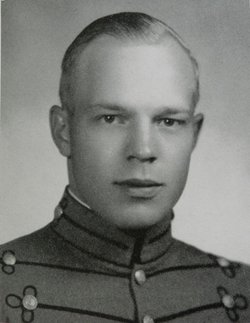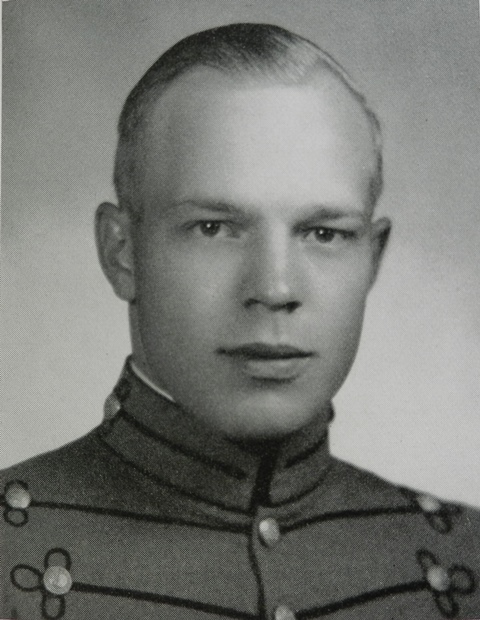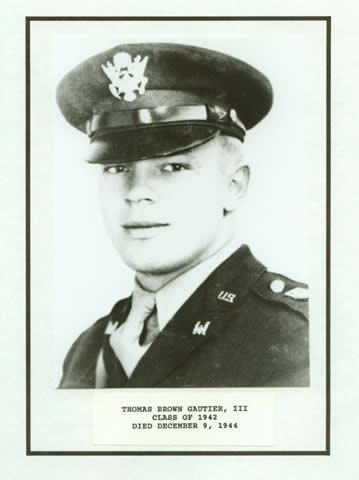Born January 20, 1921 to Thomas B, and Carrie P. Brown in Charleston, South Carolina, Thomas Jr. graduated from Orlando Senior High School in 1938 and entered The Citadel with the class of 1942.
During his “Freshman Week” September 4-9, 1939 the newspapers were filled with news that the British and French were at war with the Germans.
Thomas graduated in June 1942 with a degree in Civil Engineering and was commissioned in the Infantry. He transferred to the Engineers and assigned to the 111th Engineer Combat Battalion, 36th Infantry Division. He was promoted to 1st Lieutenant November 9, 1942 and in March 1943 he was engaged to Miss Virginia Cannon or Boston, Massachusetts. He shipped overseas with the 36th Division in April 1943 to North Africa where his father, Captain Thomas B. Gautier Sr., Engineer Corps., was on hand to meet him.
1LT Gautier was sent as observer to the 9th Infantry Division during the Tunisian Campaign. He trained for the invasion of Italy attending the Fifth Army school of mines and booby-traps and the invasion school.
Landing with his platoon at Salerno September 9, 1943, he was involved in the fighting to capture Altavilla, and assisted materially in clearing the port and docks of Naples following its liberation by the Fifth Army. He also participated in the landings at Anzio. Promoted to Captain in March 1944, he was the youngest officer in his battalion.
Landing at Camel Green Beach August 15, 1944 on the French Riviera during Operation Dragoon, Captain Gautier performed an act of heroism for which he was awarded The Soldier’s Medal. This medal is awarded in peacetime or wartime for acts not necessarily involving contact with the enemy. His citation reads: For heroism on 15 August, 1944 in France. In the invasion of Southern France, a large landing craft approaching the coast was struck squarely by an enemy glider bomb. The seriously damaged vessel, loaded with heavy artillery, ammunition and personnel, drifted ashore in flames and the ammunition began to explode. Although the personnel of headquarters and service company had been moved inland from the beach to escape the hurtling shell fragments, Captain Gautier and some companions returned to the shore near the burning ship and began rescue work. Aware of the desperate plight of the men who had been forced to abandon the craft by leaping overboard into the water, the rescue party worked indefatigably until midnight, swimming alongside the shop and dragging the men ashore. As the injured men were brought to the beach they were carried to a place of safety and given first aid treatment. Captain Gautier and his companions did not cease their unselfish and hazardous work until they had saved 75 men from drowning and had treated another 15 for burns, wounds and shock.”
Captain Gautier commanded Headquarters and Service Company through the fighting in the Vosges mountains and into the Colmar region of France. Near Sélestat, France, December 7, 1944, Captain Gautier would be awarded the Silver Star posthumously for gallantry in action. “When the bridge spanning a creek was demolished, Captain Gautier was assigned the mission of selecting a new site for a vehicle bridge to be erected over the creek. Given the choice of making the reconnaissance by plane or by vehicle, he decided to travel by vehicle in order to obtain more detailed information.
Upon nearing the creek bank, he dismounted and started to cross an open filed toward the blown bridge. Knowing that the terrain might be mined, he unselfishly refused to let his two men accompany him to the creek. As he reached the bank, he stepped on a hidden anti-personnel mine and mortally wounded by the explosion.
His heroic sacrifice inspired his men to complete the mission and obtain the vital information.
CPT Gautier was interred in the temporary U.S. Military Cemetery at Epinal, France. Following the war, in accordance with his family’s wishes, he was repatriated to the United States and buried in Arlington National Cemetery in section 34, grave 3945 on July 22, 1949.
He was twenty-three years old.
His father served twenty months overseas, was wounded and evacuated back to Stark Army General Hospital at Charleston, SC in December 1943. After recuperating he was assigned to Camp Sutton, Monroe County, NC. Camp Sutton was a training camp for the army, and the largest Prisoner of War compound in North Carolina.
Born January 20, 1921 to Thomas B, and Carrie P. Brown in Charleston, South Carolina, Thomas Jr. graduated from Orlando Senior High School in 1938 and entered The Citadel with the class of 1942.
During his “Freshman Week” September 4-9, 1939 the newspapers were filled with news that the British and French were at war with the Germans.
Thomas graduated in June 1942 with a degree in Civil Engineering and was commissioned in the Infantry. He transferred to the Engineers and assigned to the 111th Engineer Combat Battalion, 36th Infantry Division. He was promoted to 1st Lieutenant November 9, 1942 and in March 1943 he was engaged to Miss Virginia Cannon or Boston, Massachusetts. He shipped overseas with the 36th Division in April 1943 to North Africa where his father, Captain Thomas B. Gautier Sr., Engineer Corps., was on hand to meet him.
1LT Gautier was sent as observer to the 9th Infantry Division during the Tunisian Campaign. He trained for the invasion of Italy attending the Fifth Army school of mines and booby-traps and the invasion school.
Landing with his platoon at Salerno September 9, 1943, he was involved in the fighting to capture Altavilla, and assisted materially in clearing the port and docks of Naples following its liberation by the Fifth Army. He also participated in the landings at Anzio. Promoted to Captain in March 1944, he was the youngest officer in his battalion.
Landing at Camel Green Beach August 15, 1944 on the French Riviera during Operation Dragoon, Captain Gautier performed an act of heroism for which he was awarded The Soldier’s Medal. This medal is awarded in peacetime or wartime for acts not necessarily involving contact with the enemy. His citation reads: For heroism on 15 August, 1944 in France. In the invasion of Southern France, a large landing craft approaching the coast was struck squarely by an enemy glider bomb. The seriously damaged vessel, loaded with heavy artillery, ammunition and personnel, drifted ashore in flames and the ammunition began to explode. Although the personnel of headquarters and service company had been moved inland from the beach to escape the hurtling shell fragments, Captain Gautier and some companions returned to the shore near the burning ship and began rescue work. Aware of the desperate plight of the men who had been forced to abandon the craft by leaping overboard into the water, the rescue party worked indefatigably until midnight, swimming alongside the shop and dragging the men ashore. As the injured men were brought to the beach they were carried to a place of safety and given first aid treatment. Captain Gautier and his companions did not cease their unselfish and hazardous work until they had saved 75 men from drowning and had treated another 15 for burns, wounds and shock.”
Captain Gautier commanded Headquarters and Service Company through the fighting in the Vosges mountains and into the Colmar region of France. Near Sélestat, France, December 7, 1944, Captain Gautier would be awarded the Silver Star posthumously for gallantry in action. “When the bridge spanning a creek was demolished, Captain Gautier was assigned the mission of selecting a new site for a vehicle bridge to be erected over the creek. Given the choice of making the reconnaissance by plane or by vehicle, he decided to travel by vehicle in order to obtain more detailed information.
Upon nearing the creek bank, he dismounted and started to cross an open filed toward the blown bridge. Knowing that the terrain might be mined, he unselfishly refused to let his two men accompany him to the creek. As he reached the bank, he stepped on a hidden anti-personnel mine and mortally wounded by the explosion.
His heroic sacrifice inspired his men to complete the mission and obtain the vital information.
CPT Gautier was interred in the temporary U.S. Military Cemetery at Epinal, France. Following the war, in accordance with his family’s wishes, he was repatriated to the United States and buried in Arlington National Cemetery in section 34, grave 3945 on July 22, 1949.
He was twenty-three years old.
His father served twenty months overseas, was wounded and evacuated back to Stark Army General Hospital at Charleston, SC in December 1943. After recuperating he was assigned to Camp Sutton, Monroe County, NC. Camp Sutton was a training camp for the army, and the largest Prisoner of War compound in North Carolina.
Gravesite Details
CAPT AGF CO H S 111TH CORPS ENGRS 36 DIV
Other Records
Sponsored by Ancestry
Advertisement
Records on Ancestry
Advertisement







